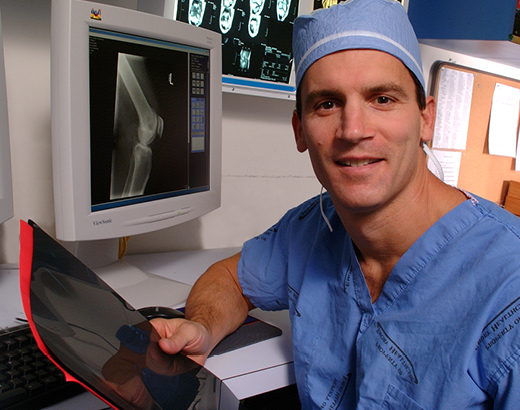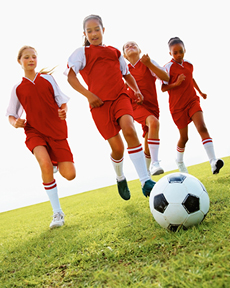A (Proper) Jump Forward

Dr. X helps young athletes prevent ACL tears.
John Xerogeanes knows all too well what can happen if an athlete takes a jump and lands wrong.

|
Each year, the chief of Emory’s Sports Medicine Center treats athletes of all ages—from the 8-year-old soccer player to the professional athlete—who’ve torn the knee’s anterior cruciate ligament, better known as the ACL.
Medical technology has made the ACL surgery more effective. Because of recent advances by Emory doctors in collaboration with Georgia Tech engineers, sports medicine orthopedists can now translate MRIs into 3D images, making preparation for ACL surgery easier and surgeons less likely to damage the knee’s growth plate. The result, says Xerogeanes, or Dr. X as his patients call him, is that “we can do an operation that’s much faster and less invasive, without the use of X-ray radiation. And that’s pretty cool.” So cool, in fact, that kids have come from as far away as Alaska for 3D-MRI-assisted surgery.
But Xerogeanes isn’t content with treating a problem that can be avoided in the first place. After all, the costs—both economic and physical—are high. “You have an ACL injury, and the financial cost is around $20,000,” he says. “You’re out of play for 8 to 12 months. It takes about 18 months to reach the level of function you had prior to the injury. Then there’s the emotional trauma and risk of re-injury.”
Previous work on ACL injury prevention has focused on teaching individual athletes to change their body mechanics when they come down from a jump: adjusting the angle of their hips, knees, and ankles. But, says Xerogeanes, “It takes money and people to teach people how to jump and to give them feedback. No one has the resources to do it.”
Bioengineering solutions
So Xerogeanes is once again teaming up with Allen Tannenbaum and Georgia Tech engineers, to create a free, web-based system that uses computer programming to provide individual feedback about whether a person’s jumping mechanics put him or her at risk for an ACL tear. Athletes of all ages can upload videos of themselves jumping, and the program will automatically analyze body angles and provide feedback. A split-screen will show the difference between a proper, safe jump and your own jumping—and then show you what you need to do differently. “And you practice for a while and film yourself again at any interval you want,” says Xerogeanes.
The website should be up and running by this fall. Doctors are hopeful that it will help athletes prevent injury and pave the way for more insight into the causes of ACL tears. After all, females are at least four times more likely to tear their ACLs than males, and having access to encrypted data about women’s jumping styles may help provide answers as to why.
These answers are coming not a moment too soon for specialists in sports medicine. “Every girl who has ACL problems in high school ends up with significant knee issues as they age,” Xerogeanes says. “I have a whole litany of female athletes who are high level whose knees are shot, and they’re only 30 years old. It’s a big deal.”
But a web program that can help thousands of athletes at a time for free? That, he hopes, is an even bigger deal—for patients.—Dana Goldman
|
Web Connection: Emory sports medicine specialists are using the 3D imaging technique pioneered at Emory for better ACL surgery results. To speak with an Emory sports medicine specialist, call 404-778-7777 or visit emoryhealthcare.org/connecting/healthconnection.html. |
||||


